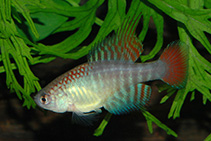| Family: |
Rivulidae (Rivulines), subfamily: Cynolebiinae |
| Max. size: |
6 cm TL (male/unsexed) |
| Environment: |
benthopelagic; freshwater, non-migratory |
| Distribution: |
South America: Tocantins River basin, Brazil. |
| Diagnosis: |
Dorsal soft rays (total): 15-23; Anal soft rays: 18-24; Vertebrae: 26-28. Female with anal fin long, spatulated, and long posterior process of occipital, terminating in narrow posterior extension; flanks with iridescent blue bars. Male with dorsolateral regions of head red, with blue spots on center of scales; bars on anal and caudal fins; with filamentous rays along the entire distal border of dorsal and anal fins. Dorsal-fin rays 20-23 in male (no dark zones), 15-18 in female; anal-fin rays 20-24 in male, 18-22 in female; caudal-fin rays 24-25, caudal fin subtruncate in male, rounded in female (Ref. 49550). |
| Biology: |
Bottom spawner, 4 months. Is difficult to maintain in aquarium (Ref. 27139). |
| IUCN Red List Status: |
Endangered (EN); Date assessed: 07 November 2018 (B2ab(ii,iii,iv)) Ref. (130435)
|
| Threat to humans: |
harmless |
Source and more info: www.fishbase.org. For personal, classroom, and other internal use only. Not for publication.
